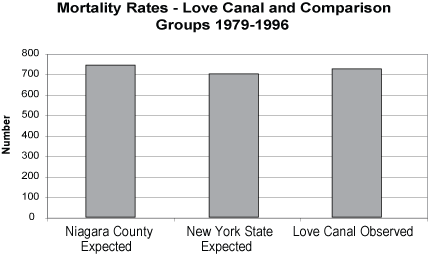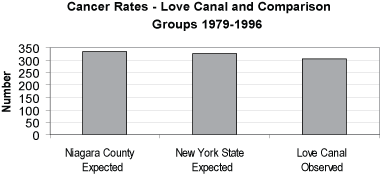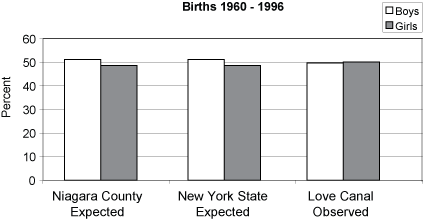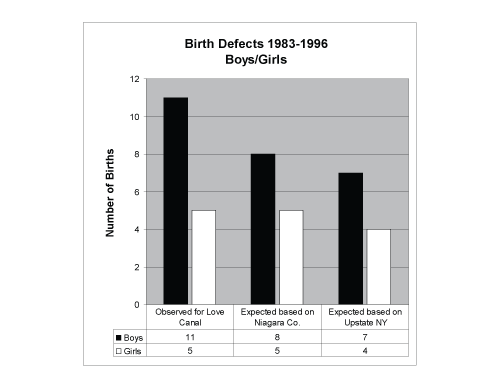Love Canal Follow-up Health Study
Reporting the Love Canal Follow-up Health Study
Summary
The Love Canal Follow-up Health Study is nearing completion. Most of the remaining work involves writing reports. In July, 2005, we sent a grant report to ATSDR that discusses all study efforts up to that time. The report, which is summarized in this newsletter, covers site history, background, prior health studies, exposure assessment, study methods, findings, interpretation and unfinished tasks. Much of the reproductive, cancer and mortality study work was done when the report was written, and those findings are discussed in the report. Future tasks are recommended. ATSDR sent the report to independent scientists for peer review. We responded to the peer reviewers, and then asked the Love Canal Expert Advisory Committee to review this report at a conference call in July, 2006. We are seeking public comment on the grant report until January 8, 2007. Comments will be summarized, responses prepared, and the report finalized.
A new contract with ATSDR calls for science journal articles that will be written for each of the four separate studies - mortality, cancer, reproductive outcomes and blood serum. They will also include the results of further data analyses recommended in the grant report and currently being performed. Science journals typically publish short, technical articles of interest to other scientists. Journals use their own peer reviewers to comment on the articles before they are published. The Expert Advisory Committee and others who have participated in study decisions will review the preliminary serum results, just as they have done for the other studies. A summary of each article will be included in future newsletters.
There will be two additional Committee meetings. On November 8 and 9, 2006, we will discuss the statistical analysis of serum LCIC levels with the Committee. The meeting will also mark the beginning of the public comment period for the grant report. We will have an availability session the evening of November 8 and researchers will talk to the public about the study results, strengths and limitations of their work, and respond to questions or concerns. The last meeting for the study is scheduled for sometime in 2008 and will be a wrap-up meeting to discuss the study findings. While technical journal reports encourage discussion among the scientific community about the findings, they do not promote discussion among residential communities or others who may wish to comment on the results. We will work with the Expert Advisory Committee and its community consultants to structure the wrap-up meeting to accomplish this goal.
CAUTION! Small Numbers
Why do epidemiologists include a caution about their result when it is based on small numbers of observations? Most epidemiology studies get information about the health and behavior of people. For example, if they want to know something about the sex of children born in the US, they could obtain information about every birth in the country and describe what they found. Getting information about every birth in the country would take an enormous amount of time and money, therefore, they get information for a large number of births to represent all the births in the country. How many births are 'a large number' is a statistical question, but it makes sense that the larger the number of births examined, the closer the results will mirror the results in the whole group.
In the Love Canal study, we got information about as many births, deaths and cancers as possible. Some health outcomes (e.g. very low birth weight) happened only a few times. For these outcomes, just one birth can greatly change the results. For example, we expect about one out of every two births, or just under 50%, to be a girl. If we look at three births and one of them is a girl, then we have only 33% girls. If two of the three births were girls then we have 67% girls. One birth changes the percentage a lot. But if we looked at 3,000 births, we would expect 1,500 to be girls. If 1,501 are girls, that one extra birth of a girl does not change the percentage much. With large numbers, a few extra cases do not make a large difference, but with small numbers they can make a big difference.
Since we wish to report all our results, we are reporting everything even though some are based on small numbers and should be viewed with more caution than results based on large numbers.
About the Study
The follow-up study is intended to describe the reproductive, death and cancer status of Love Canal residents, and possibly pave the way for future research. In 1996, NYSDOH began tracing 6,181 Love Canal residents who had been interviewed or identified as a minor child by their parents during an interview. ATSDR funded this work with $3 million set aside from the settlement of a lawsuit by the US Department of Justice on behalf of the EPA against Occidental Chemical Corporation and others related to the Love Canal Landfill.
The Love Canal Follow-up Health Study is four separate yet related studies: mortality, cancer, reproductive outcomes, and blood serum analyses. Each stands alone as a scientific study of Love Canal residents. They all began with the same group of individuals (or as many members of the group who could be included) and describe some aspect of their health status since 1978. Many study tasks were done once, and the results used for more than one of the studies. These common or related efforts include tracing the individuals in the study group, evaluating their likelihood of exposure to Canal chemicals, and updating and computerizing information obtained during the health status interviews done in 1978-1981.
About Comparisons
About Childhood Exposure
Researchers used two methods for classifying childhood exposure at the Love Canal. One was based upon expected behavior patterns of neighborhood children. Some who lived in the Canal area as children were grouped according to their age and distance from the Canal and considered to have "childhood exposure" for the purpose of internal comparisons for this study. For example, this method considered teenage boys who lived in the area while the Canal was being filled to have "childhood exposure" since they may have contacted Canal chemicals while playing. Attending the 99th Street School was used as a different measure of childhood exposure. Some analyses suggested that people with childhood exposure under the first definition have a higher likelihood of some health effects studied than did the other Love Canal residents. These results were based on small numbers (see "Caution! Small Numbers" above). Attendance at the 99th Street School did not show a similar increased risk.
Defining Exposure at Love Canal
Study researchers grouped Love Canal residents according to their estimated exposure to Canal chemicals for internal comparison (see "About Comparisons"). We identified facts about each resident that might affect their exposure, such as years of Canal residence (during active dumping, after the Canal was covered), how near they lived to the Canal, school attended, etc. The proposed groupings were discussed with our expert advisors and further developed. This method is less precise than using an exact measurement and is somewhat uncertain. We are hopeful that the serum LCIC testing will validate our definitions of exposure at Love Canal by measuring actual chemical levels from members of each of the exposure groups. Preliminary statistical analyses of the serum results will be presented and discussed at the November meeting.
Researchers worked with the expert advisors throughout the study to refine the exposure groupings. For example, exposure dates were extended for the residents in Tiers 3 and 4. In the original model, the dates of exposure ended at 1978. Since most people in Tiers 3 and 4 were not relocated until 1980, the dates of exposure will be changed to reflect this difference. Another difficult grouping was childhood exposure. Some Canal children could have come into contact with chemicals during the time of active dumping; others used surfaced chemicals such as "fire rocks" for play. We are re-examining the most common health outcomes to see whether changing the exposure definition will change the results (see new exposure definitions below).
| NEW EXPOSURE DEFINITIONS |
- - number of years living in Tiers 1 or 2 and being older than 18 years, or
- number of years living in Tiers 3 or 4 and being older than 18 years, or
- number of years living in Tiers 1 or 2 and being 18 years or younger, or
- number of years living in Tiers 3 or 4 and being 18 years or younger; and
- - total number of years living in the study area at any time, age, or tier; and
- - the same groupings as the first definition using "yes" or "no" in place of a number of years.
|
| Study Strengths |
Study Limitations |
|
|
|
Mortality Study
Love Canal residents were matched to the NYS Death Certificate Registry and the National Death Index for the years 1979 to 1996. The National Death Index provides information on deaths anywhere in the 50 United States. Death rates and causes of death in the Love Canal group were compared to New York State (excluding New York City) and Niagara County. Overall, Love Canal residents died at the same rate as those in the comparison groups; however, some causes of death occurred more often in the Love Canal group while others occurred less often. Both men and women from the Canal were more likely than their fellow New Yorkers to die of a heart attack or external causes of injury (primarily motor vehicle accidents and suicide).
Comparing Love Canal residents to each other, we observed that individuals with childhood exposure appear to be more likely to die from cancer and heart attacks than other Canal residents. However, this is based on small numbers (see Caution! Small Numbers).

Cancer Study
We matched Love Canal residents to the NYS Cancer Registry for their years of residence in NY to identify all new cancer diagnoses from 1979 to 1996. Overall, cancer rates for the Love Canal group were lower than cancer rates for other New Yorkers. In general, patterns of cancer types in the Love Canal group are similar to those seen in New York residents. Further steps were taken to increase our confidence about the finding, including grouping together cancers that are known or believed to be associated with exposure to Love Canal chemicals. The results were not different with the new analyses.
Residents with childhood exposure were diagnosed with bladder and kidney cancer at a higher than expected rate; however, this finding was based on small numbers (see Caution! Small Numbers).
Statistical modeling showed that Love Canal residents' risk of cancer increases as they age. This finding is consistent with normal patterns.

Reproductive Study
Births to women who lived at Love Canal were matched to NYS Vital Records and the Congenital Malformations Registry. We looked at baby's birth weight, weight for length of pregnancy, preterm births, baby's sex and presence of birth defects.
More girls than boys were born to Love Canal women. In the general population, typically more boys are born than girls. Women with childhood exposures were more likely to have girl babies than women who did not have childhood exposures.
Low birth weight, prematurity and small for gestational age occurred less often to Canal mothers than to upstate NY or Niagara County women. Mothers that lived near the Canal during their pregnancy were more likely to have a premature or small baby than mothers who had moved off the Canal prior to their pregnancies.
At the time of the emergency declaration, there was no birth defect registry. Researchers enlisted the help of Niagara Falls area hospitals to retrieve birth records from 1970 - 1982. Fourteen babies had medical conditions that were noted in the hospital records.

In 1983, statewide birth defects data became available from the Congenital Malformations Registry, which was created primarily because of Love Canal. The Registry matched 16 congenital malformations, or birth defects, to Love Canal mothers. This is twice what one would expect from Niagara County residents, and also higher than what is expected from other New York State communities. However, these results are based upon small numbers (see "Caution! Small Numbers").

Serum Love Canal Indicator Chemical (LCIC) Study
Love Canal residents were asked to provide blood samples for testing in 1978. Routine medical tests, such as liver and kidney function, were performed in 1979 and the results were reported to the individual's physician. Any remaining blood serum (the liquid part of a blood sample) was stored. In 1999, the Wadsworth Center for Laboratories and Research began testing about 370 qualified serum samples. Serum was tested for the presence of eight Love Canal Indicator Chemicals (LCICs). Individual results were provided to the participants in July, 2006.
The grant report to ATSDR does not discuss results of statistical analyses of the serum LCICs, as these data are currently being reviewed. This review is outlined as a next step in the report. The serum data will be compared and contrasted to the exposure groupings.
Getting a Copy of the Report
The full report is available on line at www.health.state.ny.us/environmental/investigations/love_canal/ Copies are available at the:
LaSalle Branch Library
8728 Buffalo Avenue
Niagara Falls, NY 14304
(716) 283-8309.
Contact us if you prefer to have a copy mailed to you.
NYS Health Department
547 River Street, Room 316
Troy, NY 12180-2216
Ask for Charlene Spampinato or Amanda Litwin:
518-402-7530 or 1-800-458-1158
Fax (518) 402-7539
E-mail: ceheduc@health.state.ny.us
Love Canal Meeting
Everyone is welcome to attend all or part of the Committee meetings.
Location
Holiday Inn Select, 300 Third Street,
Niagara Falls, NY 14304 (Soon to become the Crowne Plaza Niagara Falls)
Details
<1 - 5 PM Wednesday, November 8, 2006
Technical presentations and discussion of serum data
<7 - 9 PM Wednesday, November 8, 2006
Information about the study report, how to comment on the report, or ask questions of researchers
<9 AM - 1 PM Thursday, November 9, 2006
Committee discussion, next steps



